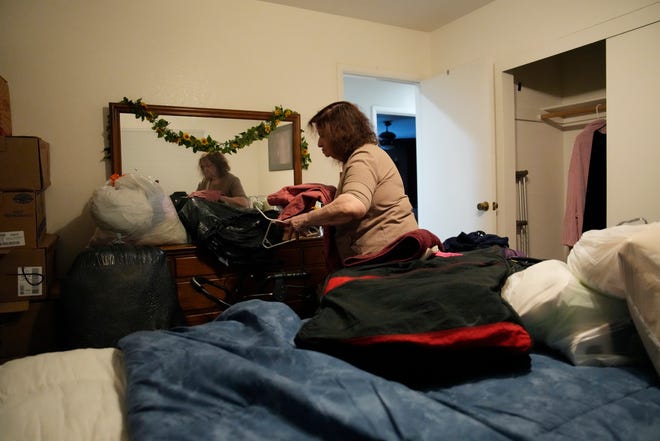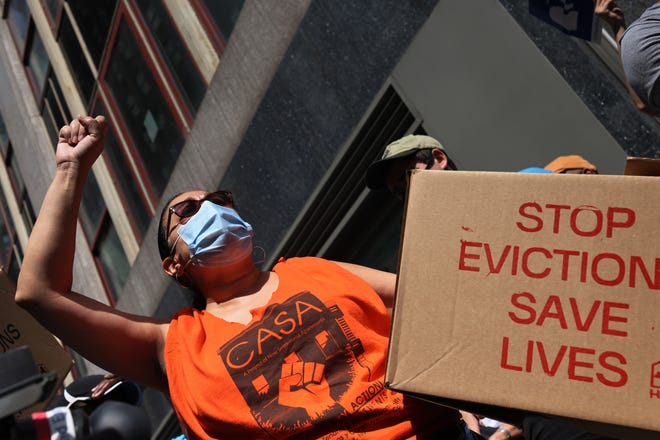
More older adults will experience housinginsecurity in the coming years unless the country dramatically increases its supply of affordable homes for people ages 65 and up, who make up roughly one-fifth of the nation.
A growing share of people with low and fixed incomes will struggle to afford appropriate housing in the coming decade, as the number of older Americans is expected to skyrocket, Harvard researchers said in a report this week. By 2040, the number of households headed by someone age 80 or older will balloon to 17 million, according to the report.
“There is a good news part of this, in that it’s not a bad thing that there are a lot more older people living longer,” Jennifer Molinsky, the report’s lead author, told USA TODAY. “We just don’t have the housing and supports that we need for this growing population.”
Because incomes decline later in life, especially after around age 80, people with the lowest incomes and the most serious health problems will have the hardest time affording both housing and necessary health care and assistance, Molinsky said.
“The older population is growing especially at those ages when people’s incomes are going down,” Molinsky said, adding that people in their 60s and 70s often have significantly higher incomes than octogenarians.
The report’s findings match other data showing a growing number of Americans will struggle with housing costs later in life, said Linna Zhu, a fellow at the Urban Institute whose research focuses on housing for older adults.
“It’s very sad. As researchers we’re looking at these numbers, but behind all that is people’s daily lives. It’s really frustrating to see the challenges seniors are facing in the housing market. We will all be there one day,” Zhu said, adding that there are key differences in housing security among people who have paid off their homes, people who still have a mortgage and renters.
Which is better?Taking Social Security at 62 or 67? It depends.
The effects of America’s widening income inequality will be more visible among older adults, as people who have faced a “lifetime of disadvantage” enter the later stages of life, Molinsky said, noting that homelessness is growing among older adults.
“The next decade is going to challenge millions of people to find adequate housing and supportive services that they need to stay in that house,” she said.

Most older adults can’t afford both housing and care
Very few older Americans can afford both their housing costs and the price of assisted living or a home health aide.
In 97 U.S. metropolitan areas, less than 1 in 5 adults age 75 or older could stretch their budgets enough to pay for both housing and care, the researchers found.
All kinds of disabilities increase with age, the report says, and more than half of people over the age of 80 report having trouble with their vision, mobility, hearing, cognition or another health issue.
The problems posed by health issues are often worse for people of color and those with lower incomes, Molinsky said.
“We see those beginning at younger ages for people of color, people with low incomes, renters,” she said referring to disabilities.
Among older adults who have paid off their mortgages and attempt to leverage their homes’ equity to get cash, applicants of color are more likely to be rejected, Zhu’s research found, making it that much harder to pay for care costs.
“The reality is it’s challenging for them to tap on their home equity,” she said. “So even if they want to age in place, there’s challenges within that bucket.”
Homeless tragedy:Four people found dead at North Carolina homeless encampment
More older adults spending a third of income on housing
Thursday’s report from Harvard’s Joint Center for Housing Studies found an all-time high of adults age 65 and older are cost-burdened, meaning they spend more than 30% of their income on housing − either a mortgage or rent.
In 2021, more than 11 million older adults were cost-burdened, up from 9.7 million in 2016, the report says.
Among older renters, 56% of households were cost-burdened in 2021, representing 4 million households, the report says. For older homeowner households, 26% were cost-burdened in 2021.
A growing share of older adults are also holding onto mortgage debt as they age, researchers found:
- In 2022, more than 40% of homeowners between the ages of 65 and 79 were paying off a mortgage.
- For homeowners aged 80 and older, that number was just over 30% in 2022.
Homelessness rising among older adults
A combination of high housing costs and lower incomes among older adults is also pushing more of them into homelessness, data shows.
Between 2019 and 2021, the number of people living in homeless shelters or other temporary housing who were between 55 and 64 rose from 19.7% to 21.3%, according to the report. And the proportion of Americans ages 65 and up in shelters ticked up too: from 5.5% to 7.4% between 2019 and 2021.
Older renters are in a particularly tough spot, Zhu said, and are far more vulnerable to homelessness because they lack home equity, have less money in their pocket after paying rent, and are more likely to have children who also are not homeowners.
There’s also a serious lack of affordable, “aging-friendly” rental units on the market, she said.
The housing market pressures, combined with the threat of eviction means, “in the end a lot of them tend to become homeless, and have rapidly declining health,” Zhu said.
In California, a recent study found more than 40% of older homeless individuals first fell into homelessness after age 50. In gentrifying Boston neighborhoods, Molinsky said, the same trend was recently observed when landlords raised rents to levels past what longtime older residents could afford.

More older adults will be renters, researchers found
Systemic inequality has led to more older adults renting because they can’t afford to buy a home, researchers found.
“The unaffordability and rising house prices make homeownership a more challenging task for all us,” Zhu said. “Baby boomers, they are also facing this affordability crisis.”
Among adults ages 50-64, homeownership rates have been decreasing steadily for more than a decade, pointing to a future scenario where more adults in their 70s and 80s will be renters, Molinsky said.
Rates of homeownership among Black Americans continue to be lower than for whites, according to the report, due to racist housing policies that prevented generations of would-be Black homeowners from getting approved for mortgages. In turn, Black families pass down less generational wealth, according to Molinsky.
“That’s a significant reason for many of these disparities,” she said.






